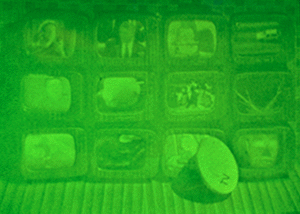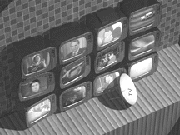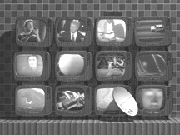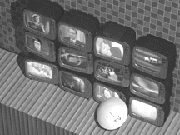

Created from 200 computer
generated images.
Three examples are as follows:



|
A great deal was learned from the research done on this project. Examples of the artwork used in this project are seen above. The reason for going through the trouble of rendering all the TV sets is because the typical hologram allows you to see things by moving the hologram from side to side but if you tilt the hologram to the upper right or upper left, you do not see the image from the upper right or left perspective. Scientists would say you have no parallax or ability to see the hologram from those angles. With this method, the image rotates with you as you change your perspective just as it would in real life. You have to see the hologram to fully understand the artistic benefits of this process. In theory, this process allows any degree of motion around a object. So with a large hologram you can, in theory, have a object roll around 36o degrees in any direction. As an artist, you can envision a final result that has someone holding a thin sheet of photopolymer about the size of a sheet of paper. As they tilt the sheet a object tumbles in space 360 degrees in whatever direction the viewer desires. In this experiment, the artists created a bank of TV sets and filled the screens with a frame that was captured from a live TV broadcast. It was decided that in addition to the perspective of the TV sets changing as the viewer tilted the hologram from top to bottom, the images in the TV screens would play back the video that was recorded from the TV. As an artist you might also note that this is the equivalent of a "printed cinema" . You could forget the TV sets and use the whole hologram to have a short cinema play back. At the start of the project one of the problems was that nobody knew how fast to play back the video sequence since this had never been done before. Also unknown was what type of image would work best. It was therefore decided that each set would have a different video clip. One set had Michael Jackson, another Clinton debating Dole, etc. Each video stream was played back at a different rate. Too fast of a rate would create a blur and too slow would show no motion. Also adding to the problem was the fact that all this had to be squeezed into a image area that was 5.7cm x 8.25cm (2.25in x 3.25in). As it turned out, the fastest playback was the best. Also, as you might expect, better results were achieved with video that had less demanding detail (two men debating). Although the image area is small, you can see the results and extrapolate as to how this would look in a larger format. Much more detail is available in the book where the artists spend a whole article talking about how this project was done. Since this project, others have gone on to create much larger works, some of which are in full color photopolymer and used at conventions for displays. We have yet to see people use the process for playing back cinema or using it to display 360 degree views of molecules or other products but these things should occur since the technology is here. It is not possible, of course, to demonstrate the characteristics of the hologram on the web but you can get the hologram by simply ordering the publication it is in (hmp5). You will get other artistic designs using holograms in the issue too. The cost is inexpensive ($20) and can be ordered here. |

![]() Return to Graphic Artists Gallery
Return to Graphic Artists Gallery
| Ross
Books PO Box 4340 Berkeley, California 94704 USA |
Phone: (510) 841 2474 Toll Free USA: (800) 367 0930 Fax: (510) 841 2695 Email: sales@rossbooks.com |